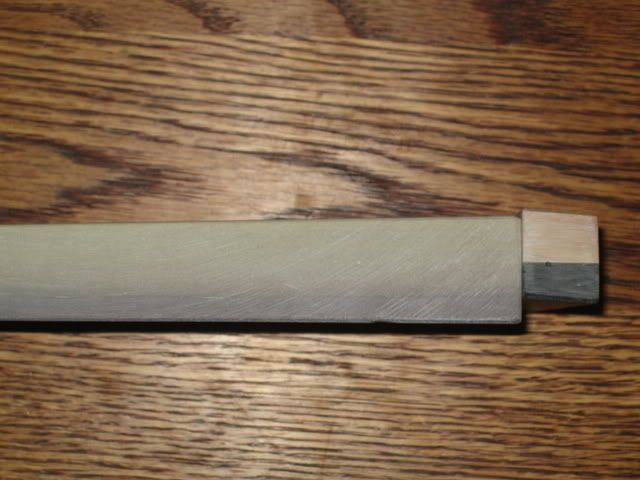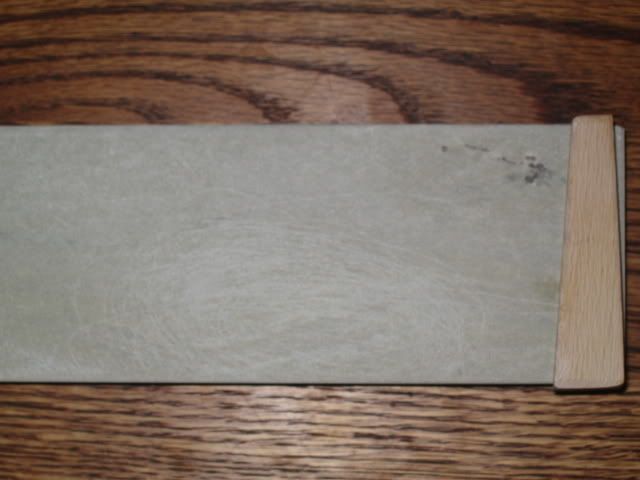Results 1 to 10 of 29
Thread: Is my Yellow really a Yellow?
Hybrid View
-
02-09-2009, 09:35 PM #1
 Is my Yellow really a Yellow?
Is my Yellow really a Yellow?
Gents,
I just received my first coticule today from xxxxxx. It's supposed to be a combination blue/yellow. I know that coticules very immensely in colors, but my "Yellow" sure looks blue to me. Check out the pictures... the small slurry stone is definitely a yellow. It really makes my big "yellow" look like a BBW. What do you guys think? Is it a BBW or Yellow?


Edit: removed vendor name, because I want to avod the "take it up in private" thing, and get you guy's opinion on this *before* I take it up with the vendor.Last edited by FloorPizza; 02-09-2009 at 09:44 PM.
-
02-09-2009, 09:39 PM #2There is no charge for Awesomeness



- Join Date
- Aug 2006
- Location
- Maleny, Australia
- Posts
- 7,977
- Blog Entries
- 3
Thanked: 1587
It is hard to say from the photo, but one thing I have noticed is that the BBW kind of "shimmers" whereas the coticule is more matt. It looks from your pic to be matt.

The BBW also produces a purple-ish slurry. Maybe you should try to make a slurry and see what happens?
Also, if it is a natural combo I think you would have to expect some blending of the two rock types where the seams meet. Maybe you got one where the yellow is thinnish and the blue comes through? All that matters though is how it works. Try it on some razors and see how it goes.
James.Last edited by Jimbo; 02-09-2009 at 09:43 PM.
<This signature intentionally left blank>
-
02-09-2009, 09:45 PM #3
 test it
test it
I think you will find out when you test it.Try it in almost shave ready blade and check the edge after 10-20 passes.Check the edge if it is brakes then not good coticule ,not brakes smooths edge then good one.Of course you will need to have small handy microscop.Color doesn't mean a lot .Good luck
-
The Following User Says Thank You to hi_bud_gl For This Useful Post:
FloorPizza (02-09-2009)
-
02-09-2009, 09:50 PM #4There is no charge for Awesomeness



- Join Date
- Aug 2006
- Location
- Maleny, Australia
- Posts
- 7,977
- Blog Entries
- 3
Thanked: 1587
Actually, is the top photo a side-on shot? Because I think I can see the blue and yellow transition in that shot.
But yeah, test it. Photos do not tell much of a story with any hone. How it works is the only test.
James.<This signature intentionally left blank>
-
The Following User Says Thank You to Jimbo For This Useful Post:
FloorPizza (02-09-2009)
-
02-09-2009, 10:08 PM #5Coticule researcher

- Join Date
- Jan 2008
- Location
- Belgium
- Posts
- 1,872
Thanked: 1212
It's a natural Coticule. Sometimes the transition between the Blue and the Yellow is a hard edge, sometimes it's a slow transgression. You might want to think that's not good, but for finishing you could be very pleasantly surprised. Usually Coticules that have a greenish shade, are slow slurry-cutters. But they have a good reputation for finishing.
You should definitely test is. Try finishing with water only. If you want to test it for slurry-cutting, raise the slurry with a DMT, instead of a slurry stone. That way you're only testing the slurry of the hone, and not the slurry of your slurry stone.
Should you find it on the slow side, use a "fast" slurry stone, and test again. On slower Coticules, the slurry stone can really make a difference.
If I had to pick one on merely seeing it, I would prefer this one over one that has the color of your slurry stone.
By the way, how does it smell (when you raise a slurry on it)?
Hope this works out for you,
Bart.
-
The Following 2 Users Say Thank You to Bart For This Useful Post:
Cornelius (02-09-2009), FloorPizza (02-09-2009)
-
02-09-2009, 10:17 PM #6
-
02-09-2009, 10:22 PM #7

Bart, your ability to mind read is phenomenal.
 I was going to remark about the very "earthy" smell of the coticule in a write-up I was going to do later after honing a few blades with it. I loooooove the smell of the coticule! You've hiked the Ardennes region... does the air smell like this??
I was going to remark about the very "earthy" smell of the coticule in a write-up I was going to do later after honing a few blades with it. I loooooove the smell of the coticule! You've hiked the Ardennes region... does the air smell like this??
And you have the color nailed. It seems quite green in color. I'm glad to hear it has a good reputation for finishing, since that's really what I want it for. I want to pit it against the finishing ability of the shapton 16k. Although I must say that I also do plan on using the coticule *after* the Shapton 16k and 30k to see if I can retain the sharpness of the shaptons, but "refine" the edge (more comfort) with the coticule. So many things to test... so little time.
Thanks for the help, gents, I knew you guys would have this figured out for me in no time.
-
02-10-2009, 12:50 AM #8Senior Member

- Join Date
- Aug 2006
- Posts
- 882
Thanked: 108
Bingo.
You've got what I've always called a "green coticule."
They do look quite different from the traditional yellows.
I had one that I bought from Howard. I sold it because I got a Y/G escher that became my preferred finisher. I sort of regret it....
Keep it. They're super finishers. They are not cousins of the blue. They're their own thing. Send a thank-you letter to xxxxxx.
-
The Following User Says Thank You to dylandog For This Useful Post:
FloorPizza (02-10-2009)
-
02-09-2009, 10:12 PM #9

It is, but it looks like it transitions from dark BBW to light BBW.... being a total coticule newb, I don't know. The slurry the dark side produces is very purple. The slurry the "yellow" side produces is quite a bit lighter, but not nearly as light as the slurry the small yellow stone makes. I made the slurries with a DMT, btw.
This must be a natural combination stone, as the blue side includes all the way to the surface of the yellow. Also, the graduation from blue to "yellow" is very gradual, with strong demarcations in only a couple of places.
Is a DarkBBW/LightBBW natural combo stone a possibility?Last edited by FloorPizza; 02-09-2009 at 10:29 PM.
-
02-09-2009, 10:22 PM #10
 belgian
belgian
you are getting confused yourself.Don't pay attention to colors.100% this stone is natural combo stone .Possible you have get better stone then usual people gets.No one knows untill you will test it .check this picture. i think you are expecting similar this stone? but you need to know how your stone acts that is all matter .if it is acts similar 4k then forget about if it acts same as 10k or more then you must be very happy.This is why you need to test it.use blade and sharpen it.then check it undo microscope see what happens to your edge?
Both natural combo
small one is light color then big one and small is a lot better sharpener.
-
The Following User Says Thank You to hi_bud_gl For This Useful Post:
FloorPizza (02-09-2009)


 LinkBack URL
LinkBack URL About LinkBacks
About LinkBacks






 Reply With Quote
Reply With Quote

